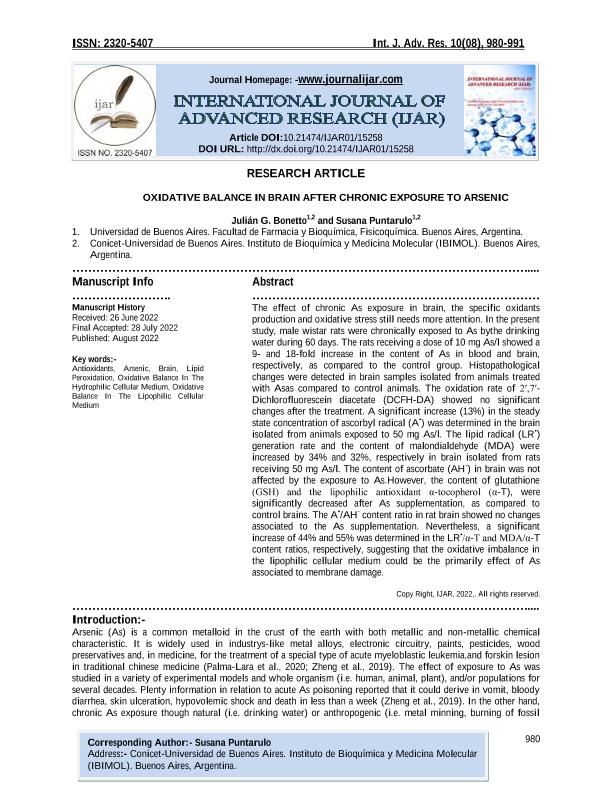Mostrar el registro sencillo del ítem
dc.contributor.author
Bonetto, Julián Gerardo

dc.contributor.author
Puntarulo, Susana Ángela

dc.date.available
2023-07-14T15:36:15Z
dc.date.issued
2022-08
dc.identifier.citation
Bonetto, Julián Gerardo; Puntarulo, Susana Ángela; Oxidative balance in brain after chronic exposure to arsenic; International Journal of Advanced Research; International Journal of Advanced Research; 10; 8-2022; 980-991
dc.identifier.issn
2320-5407
dc.identifier.uri
http://hdl.handle.net/11336/203989
dc.description.abstract
The effect of chronic As exposure in brain, the specific oxidantsproduction and oxidative stress still needs more attention. In the presentstudy, male wistar rats were chronically exposed to As bythe drinkingwater during 60 days. The rats receiving a dose of 10 mg As/l showed a9- and 18-fold increase in the content of As in blood and brain,respectively, as compared to the control group. Histopathologicalchanges were detected in brain samples isolated from animals treatedwith Asas compared to control animals. The oxidation rate of 2ʹ,7ʹ-Dichlorofluorescein diacetate (DCFH-DA) showed no significantchanges after the treatment. A significant increase (13%) in the steadystate concentration of ascorbyl radical (A?) was determined in the brainisolated from animals exposed to 50 mg As/l. The lipid radical (LR?)generation rate and the content of malondialdehyde (MDA) wereincreased by 34% and 32%, respectively in brain isolated from ratsreceiving 50 mg As/l. The content of ascorbate (AH-) in brain was notaffected by the exposure to As.However, the content of glutathione(GSH) and the lipophilic antioxidant α-tocopherol (α-T), weresignificantly decreased after As supplementation, as compared tocontrol brains. The A?/AH- content ratio in rat brain showed no changesassociated to the As supplementation. Nevertheless, a significantincrease of 44% and 55% was determined in the LR?/α-T and MDA/α-Tcontent ratios, respectively, suggesting that the oxidative imbalance inthe lipophilic cellular medium could be the primarily effect of Asassociated to membrane damage.
dc.format
application/pdf
dc.language.iso
eng
dc.publisher
International Journal of Advanced Research
dc.rights
info:eu-repo/semantics/openAccess
dc.rights.uri
https://creativecommons.org/licenses/by/2.5/ar/
dc.subject
ANTIOXIDANTS
dc.subject
ARSENIC
dc.subject
BRAIN
dc.subject
OXIDATIVE BALANCE IN THE LIPOPHILIC CELLULAR MEDIUM
dc.subject.classification
Bioquímica y Biología Molecular

dc.subject.classification
Ciencias Biológicas

dc.subject.classification
CIENCIAS NATURALES Y EXACTAS

dc.title
Oxidative balance in brain after chronic exposure to arsenic
dc.type
info:eu-repo/semantics/article
dc.type
info:ar-repo/semantics/artículo
dc.type
info:eu-repo/semantics/publishedVersion
dc.date.updated
2023-07-05T12:08:00Z
dc.journal.volume
10
dc.journal.pagination
980-991
dc.journal.pais
India

dc.description.fil
Fil: Bonetto, Julián Gerardo. Consejo Nacional de Investigaciones Científicas y Técnicas. Oficina de Coordinación Administrativa Houssay. Instituto de Bioquímica y Medicina Molecular. Universidad de Buenos Aires. Facultad Medicina. Instituto de Bioquímica y Medicina Molecular; Argentina
dc.description.fil
Fil: Puntarulo, Susana Ángela. Consejo Nacional de Investigaciones Científicas y Técnicas. Oficina de Coordinación Administrativa Houssay. Instituto de Bioquímica y Medicina Molecular. Universidad de Buenos Aires. Facultad Medicina. Instituto de Bioquímica y Medicina Molecular; Argentina
dc.journal.title
International Journal of Advanced Research
dc.relation.alternativeid
info:eu-repo/semantics/altIdentifier/doi/http://dx.doi.org/10.21474/IJAR01/15258
Archivos asociados
